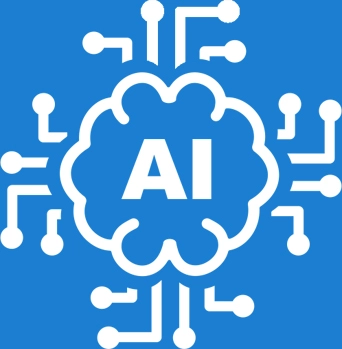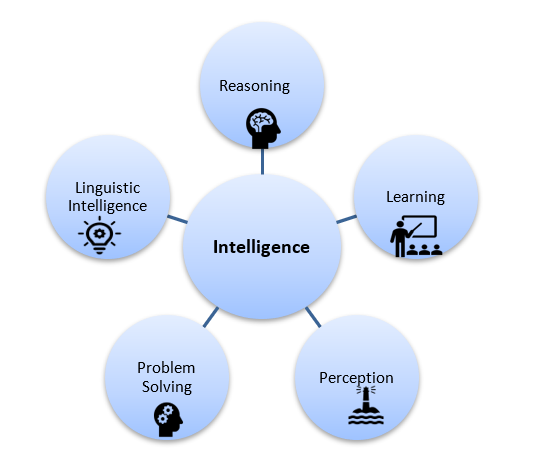Intelligent system
While studying Artificial Intelligence, you must know about what Intelligence is?
What is intelligence?
Defining Intelligence in a single sentence is hard and it means different things to different people. Intelligence has so many aspects. In general, Intelligence can be defined as the ability to make decisions, problem-solving, creativity, and adjusting to new situations for survival in a diverse environment.
The ability of a human being to learn from the situation, make decisions concerning the condition, solve problems in the surroundings, adjusting or trying newly arriving situations is called the HUMAN INTELLIGENCE. It can be defined as the power or mental capacity of a human. An example of human intelligence is someone who stays away from fire.
What is intelligence composed of?
Intelligence is composed of
- Reasoning
- Learning
- Problem Solving
- Perception
- Linguistic Intelligence
- REASONING -The set of processes that enables us to provide Predictions, construct explanations, and conclude is called Reasoning.
- LEARNING Learning is a process that enhances the awareness of the subject of study from gaining knowledge or skill by studying, practicing, being thought, or experiencing.
- PROBLEM-SOLVING -One tries to get into the desired solution from a present situation. It also involves the process of decision-making where the best suitable alternative is selected from multiple alternatives to reach the desired conclusion.
- PERCEPTION -Perception means getting aware of something.. Sensors are used to aid perception.
- LINGUISTIC INTELLIGENCE -The ability to use, speak, write verbal and written language.
When human intelligence is possessed by a machine, not all but some aspects It can be called MACHINE INTELLIGENCE. Systems designed with machine intelligence are called INTELLIGENT SYSTEMS. NOW
What are intelligent systems?
When the abilities of Reasoning, Learning, Problem Solving, and Perception are incorporated with man-made machines, we call them Intelligent Systems or by definition Machines with advanced technology that perceive and respond to the world around them are called intelligent systems. The intelligence of a system can be defined as the ability of the system to
- Calculate
- Reason
- Learn from experience
- Store and retrieve information from memory
- Solve problems
- Use natural language fluently
- Generalize
- Adapt new situations
An intelligent system can be called a collection of interconnected intelligent devices, networks, other large systems, and software. An intelligent system can gather information from the environment, analyze that data, and communicate with other systems.
Why the intelligent system is important?
Intelligent systems have a great deal of knowledge about some domains. They are technically advanced machines that can respond to the world around them. It has a high degree of complexity in the decision-making process and also can explain its action. The most important feature of an intelligent system is its ability to interact with humans to teach or provide assistance for complex information processing effectively.
An intelligent system is employed in professional domains such as medical diagnosis(recognizing tumors) airport management(air traffic flow management) and for monotonous work (autonomous car driving or hose cleaning) and dangerous tasks like underwater exploration.
Properties of intelligent system
- Operates in a complex world with limited available resources.
The information processing capacity of the system is less than the complexity of the world. The entire information about the world cannot be completely represented in the intelligent system’s memory.
The world consists of two components, environment, and agents. The system observes the environments through sensors and initiates actions using actuators. Example: A thermostat illustrates the concept of a system that operates in an environment. It uses a thermometer to sense the temperature of the room (environment) and perform an action by starting or stopping a heater. The system interacts with the user by establishing the desired temperature. The use of sensors and actuators separates the system body from the rest of the environment. The intelligent agent is placed in the environment.
- Possesses primary cognitive abilities.
Intelligent systems possess four primary cognitive abilities
1. Perception: Extracting information from the environment.
2. Deliberation: Reasoning the world and deciding on actions.
3. Interaction: Communication with agents
4. Action control: Controlling the execution of actions.
Perception and action control are divided into multiple separate components that operate parallel with a high frequency and Deliberation and interaction which is necessary for reasoning operates sequentially.
Example: Self-driving cars are an example of an intelligent system that illustrates the 4 primary cognitive abilities. The car senses the world with the help of cameras, accelerometers, acoustic sensors, etc. Perception is achieved with the help of perceptual components specialized in the recognition of objects(pedestrians, traffic signals, other vehicles). Action control is executed by steering, brake, accelerator, etc. Deliberation is concerned with the ability to generate a path to reach the final destination. Interaction is performed by presenting the path to follow to reach the destination to the user and also presenting information about the environment helps the user to execute the trip correctly.
- Exhibits complex intelligent behavior.Rational action, adapting decisions through learning, and introspection are the abilities that describe the complex intelligent behavior of a system.
- Rational action:- To obtain maximum performance in the best possible way, the intelligent system with rational action uses its cognitive abilities. For example: In a medical diagnosis system the number of times that the disease is correctly diagnosed is considered as the measure of performance. The exact performance measure cannot be obtained by an intelligent system but estimations are done on expected performance. This can be programmed explicitly with a decision-making algorithm(eg. Decision theory). Cognitive abilities like perception, interaction, deliberation, and actuations are used to perform rational decisions.
- Adaptation through learning:- The intelligent system obtains the capacity to adapt to the changing world through learning. Cognitive abilities like perception and action control can be improved through learning. An intelligent system can use an internal method or external method to make a value judgment to evaluate its behavior. This evaluation of the system’s behavior helps to change the internal model to modify its future behavior.
- Introspection:- This is the ability to analyze how the cognitive abilities of its own can operate. A model with introspection can be used as the input for algorithms to simulate the self-awareness process. This ability allows the system to perform explanations to an external agent.
Two types of intelligent system
Two Intelligent systems are Intelligent Tutoring System (ITS) and Expert Systems.
1. INTELLIGENT TUTORING SYSTEM
As the name indicates, the ITS provides instruction to the user (student) similar to a human tutor. ITS provides personalized instruction and feedback to its users. Certain studying strategies are suggested by the system with the help of deep learning algorithms for individuals. It continuously tracks the user’s progress and provides next step hints and chooses practice problems that help the user to improve or learn new skills. ITS will enable the user to work to reach the successful conclusion of problem-solving. It provides instructions in the problem-solving context and also helps to get an understanding of the problem-solving knowledge.
Examples for ITS
- Tracing Tutors
- Stoich Tutor
- iTalk2Learn
- Duolingo Chatbot
- Thinkster Math
2. EXPERT SYSTEMS
The expert system contains an expert's knowledge or expert’s knowledge about some domain (nuclear industry, accounting, etc). The knowledge base which contains all the specialized and technical knowledge an expert possesses is the most important part of an Expert System. Knowledge from more than one expert is integrated within the knowledge base of an Expert system and hence can make the solutions more efficient.
The five basic types of Expert Systems are
- Rule-based expert system: Take knowledge from human experts and convert this knowledge into several hardcoded rules.
- Frame-based expert system: It is a concept of a collection of slots. Here frames are used to represent knowledge and rules play a secondary role.
- Fuzzy expert system: Based on logic. Rules are modeled from fuzzy preferences of expert's knowledge.
- Neural expert system: Advantages of a rule-based expert system and advantages of a neural network like learning, generalization, robustness, and parallel information processing are combined.
- Neuro-fuzzy expert system: Merging a neural network with a fuzzy expert system provides a more powerful technology called neuro-fuzzy systems.
The expert system generally consist of four components
- A Knowledge Base: A storage where a collection of knowledge from different experts about any particular domain or subject.
- The search or inference system: Main processing unit of expert system and hence called as the brain of an expert system. knowledge from the knowledge base is extracted and applies inference rules to the knowledge base to produce an error-free solution for user queries.
- A knowledge acquisition system: The domain knowledge is extracted, organized, and structured to acquire knowledge from various experts
- The user interface or communication system: The user interacts with the expert system through the user interface. It takes user queries as inputs and passes them to the inference engine and displays the output to the user.
Examples of Expert Systems
Application of intelligent system
In today’s society, intelligent systems are poised to fill a growing number of roles. Some of them are
- Entertainment
- Character recognition
- Visual Surveillance
- Intelligent Transportation
- Human Identification using biometric parameters.
- Education
- Medical Care
- Military Applications
- Robotics
- Factory Automation
Challenges of an intelligent system.
- DYNAMIC WORLD: -The continuously changing physical world requires decisions to be made at a fast time to accommodate the changes in the environment.
- MAPPING: - Computer vision must deal with the challenges including changes in background motion, lighting, and scale, grouping items with intra/inter-class variation. There are a lot of chances to lose information from the 3D world to the 2D world.
- UNCERTAINTY: - Any actions the intelligent system takes may be incorrect due to noise in the sensors and due to the limitations in executing actions.
- TIME-CONSUMING COMPUTATION: - Expensive computation or search through a very large state space is required for searching for the optimal path to a goal.
Difference between human and machine intelligence
|
HUMAN INTELLIGENCE
|
MACHINE INTELLIGENCE
|
| Humans become aware or conscious or understand by patterns.
Humans recall information by patterns.
Even if some part of an object is missing or distorted, Humans can figure out the object completely
|
Machines understand or become aware of a set of rules and data.
Machines recall information by searching algorithms.
Machines cannot figure out an object completely without errors with distorted information.
|





